Effect of Adding Hexagonal Boron Nitride (hBN) Nano-Powder to Lubricant on Performance and Emissions in a Two-Stroke Gasoline Engine
Abstract
:1. Introduction
2. Experimental Setup and Procedures
2.1. Experimental Setup
2.2. Lubricant and Fuel–lubricant Mixture Preparation
2.3. Experimental Procedure
3. Results and Discussion
4. Conclusions
Funding
Institutional Review Board Statement
Informed Consent Statement
Data Availability Statement
Acknowledgments
Conflicts of Interest
References
- Heywood, J.B. Two-Stroke Cycle Engine: It’s Development, Operation and Design, 1st ed.; Taylor & Francis: New York, NY, USA, 1999; pp. 1–9. [Google Scholar]
- Krishna, A.S.; Mallikarjuna, J.M.; Kumar, D. Effect of engine parameters on in-cylinder flows in a two-stroke gasoline direct injection engine. Appl. Energy 2016, 176, 282–294. [Google Scholar] [CrossRef]
- Savioli, T.; Zardin, B.; Borghi, M. Development of a 2-Stroke GDI Engine. Energy Procedia 2017, 126, 1091–1098. [Google Scholar] [CrossRef]
- Mattarelli, E.; Cantore, G.; Rinaldini, C.A. Advances in the design of two-stroke, high speed, compression ignition engines. In Advances in Internal Combustion Engines and Fuel Technologies, 1st ed.; Intech Open: Rijeka, Croatia, 2013; pp. 149–182. [Google Scholar]
- Singh, A.K. Castor oil-based lubricant reduces smoke emission in two-stroke engines. Ind. Crops Prod. 2011, 33, 287–295. [Google Scholar] [CrossRef]
- Zulfattah, Z.M.; Zulkifli, N.W.M.; Masjuki, H.H.; Harith, M.H.; Syahir, A.Z.; Norain, I.; Arslan, A. Effect of bio-based lubricant towards emissions and engine breakdown due to spark plug fouling in a two-stroke engine. J. Clean. Prod. 2019, 221, 215–223. [Google Scholar] [CrossRef]
- Broatch, A.; Margot, X.; Novella, R.; Gómez-Soriano, J. Combustion noise analysis of partially premixed combustion concept using gasoline fuel in a 2-stroke engine. J. Energy 2016, 107, 612–624. [Google Scholar] [CrossRef]
- Blair, G.P. Design and Simulation of Two-Stroke Engines; Society of Automotive Engineers: Warrendale, PA, 1996; pp. 8–73. [Google Scholar]
- Caines, A.J.; Haycock, R.F.; Hillier, J.E. Automotive Lubricants Reference Book; John Wiley & Sons: Warrendale, PA, USA, 2004; pp. 89–216. [Google Scholar]
- Arumugam, S.; Sriram, G.; Ellappan, R. Bio-lubricant-biodiesel combination of rapeseed oil: An experimental investigation on engine oil tribology, performance, and emissions of variable compression engine. J. Energy 2014, 72, 618–627. [Google Scholar] [CrossRef]
- Farfan-Cabrera, L.I.; Gallardo-Hernández, E.A.; Gómez-Guarneros, M.; Pérez-González, J.; Godínez-Salcedo, J.G. Alteration of lubricity of Jatropha oil used as bio-lubricant for engines due to thermal ageing. Renew. Energy 2020, 149, 1197–1204. [Google Scholar] [CrossRef]
- Farfan-Cabrera, L.I.; Gallardo-Hernández, E.A.; Pérez-González, J.; Marín-Santibáñez, B.M.; Lewis, R. Effects of Jatropha lubricant thermo-oxidation on the tribological behaviour of engine cylinder liners as measured by a reciprocating friction test. Wear 2019, 426, 910–918. [Google Scholar] [CrossRef]
- Cheenkachorn, K.; Fungtammasan, B. Development of engine oil using palm oil as a base stock for four-stroke engines. J. Energy 2010, 35, 2552–2556. [Google Scholar] [CrossRef]
- Öğüt, H.; Oğuz, H.; Aydın, F.; Ciniviz, M.; Deveci, H. The investigation of the use of plant-based wild mustard and boron doped oil as engine lubrication oil in diesel engines. Renew. Energy 2019, 136, 79–83. [Google Scholar] [CrossRef]
- Ali, M.K.A.; Xianjun, H.; Mai, L.; Qingping, C.; Turkson, R.F.; Bicheng, C. Improving the tribological characteristics of piston ring assembly in automotive engines using Al2O3 and TiO2 nanomaterials as nano-lubricant additives. Tribol. Int. 2016, 103, 540–554. [Google Scholar] [CrossRef]
- Ali, M.K.A.; Xianjun, H.; Mai, L.; Bicheng, C.; Turkson, R.F.; Qingping, C. Reducing frictional power losses and improving the scuffing resistance in automotive engines using hybrid nanomaterials as nano-lubricant additives. Wear 2016, 364, 270–281. [Google Scholar] [CrossRef]
- Ali, M.K.A.; Fuming, P.; Younus, H.A.; Abdelkareem, M.A.; Essa, F.A.; Elagouz, A.; Xianjun, H. Fuel economy in gasoline engines using Al2O3/TiO2 nanomaterials as nanolubricant additives. Appl. Energy 2018, 211, 461–478. [Google Scholar] [CrossRef]
- Sgroi, M.F.; Asti, M.; Gili, F.; Deorsola, F.A.; Bensaid, S.; Fino, D.; Dassenoy, F. Engine bench and road testing of an engine oil containing MoS2 particles as nano-additive for friction reduction. Tribol. Int. 2017, 105, 317–325. [Google Scholar] [CrossRef]
- Davis, D.; Shah, A.F.; Panigrahi, B.B.; Singh, S. Effect of Cr2AlC nanolamella addition on tribological properties of 5W-30 engine oil. Appl. Surf. Sci. 2019, 493, 1098–1105. [Google Scholar] [CrossRef]
- Wu, B.; Song, H.; Li, C.; Song, R.; Zhang, T.; Hu, X. Enhanced tribological properties of diesel engine oil with Nano-Lanthanum hydroxide/reduced graphene oxide composites. Tribol. Int. 2020, 141, 105951. [Google Scholar] [CrossRef]
- Dinesh, R.; Prasad, M.G.; Kumar, R.R.; Santharaj, N.J.; Santhip, J.; Raaj, A.A. Investigation of tribological and thermophysical properties of engine oil containing nano-additives. Mater. Today Proc. 2016, 3, 45–53. [Google Scholar] [CrossRef]
- Guo, Z.; Zhang, Y.; Wang, J.; Gao, C.; Zhang, S.; Zhang, P.; Zhang, Z. Interactions of Cu nanoparticles with conventional lubricant additives on tribological performance and some physicochemical properties of an ester base oil. Tribol. Int. 2020, 141, 105941. [Google Scholar] [CrossRef]
- Abdullah, M.I.H.C.; Abdollah, M.F.B.; Amiruddin, H.; Tamaldin, N.; Nuri, N.R.M. Optimization of Tribological Performance of hBN/AL2O3Nanoparticles as Engine Oil Additives. Procedia Eng. 2013, 68, 313–319. [Google Scholar] [CrossRef]
- Abdullah, M.I.H.C.; Abdollah, M.F.B.; Amiruddin, H.; Tamaldin, N.; Nuri, N.R.M. The potential of hBN nanoparticles as friction modifier and antiwear additive in engine oil. Mech. Ind. 2016, 17, 104. [Google Scholar] [CrossRef]
- Ay, N.; Ay, G.M.; Göncü, Y. Environmentally friendly material: Hexagonal boron nitride. Bor. Dergisi. 2016, 1, 66–73. [Google Scholar]
- Ramteke, S.M.; Chelladurai, H. Effects of hexagonal boron nitride based nanofluid on the tribological and performance, emission characteristics of a diesel engine: An experimental study. Eng. Rep. 2020, 2, e12216. [Google Scholar] [CrossRef]
- He, J.; Sun, J.; Meng, Y.; Yan, X. Preliminary investigations on the tribological performance of hexagonal boron nitride nanofluids as lubricant for steel/steel friction pairs. Surf. Topogr. Metrol. Prop. 2019, 7, 015022. [Google Scholar] [CrossRef]
- Ramteke, S.; Chelladurai, H. Examining the role of hexagonal boron nitride nanoparticles as an additive in the lubricating oil and studying its application. Proc. Inst. Mech. Eng. Part N J. Nanomater. Nanoeng. Nanosyst. 2020, 234, 19–36. [Google Scholar] [CrossRef]
- Senyk, S.; Chodkiewicz, A.; Gocman, K.; Szczęśniak, B.; Kałdoński, T. Hexagonal nano and micro boron nitride: Properties and lubrication applications. Materials 2022, 15, 955. [Google Scholar] [CrossRef] [PubMed]
- Cheng, Y.; Bu, Y.; Guan, P.; Yang, Y.; Qing, J. Tribological properties of hexagonal boron nitride nanoparticles as a lubricating grease additive. Lubr. Sci. 2023, in press. [Google Scholar] [CrossRef]
- Abdollah, M.F.B.; Amiruddin, H.; Jamallulil, A.D. Experimental analysis of tribological performance of palm oil blended with hexagonal boron nitride nanoparticles as an environment-friendly lubricant. Int. J. Adv. Manuf. Technol. 2020, 106, 4183–4191. [Google Scholar] [CrossRef]
- Osman, K.A.; Yılmaz, V.; Ünver, H.Ö.; Şeker, U.; Kılıç, S.E. Slot milling of titanium alloy with hexagonal boron nitride and minimum quantity lubrication and multi-objective process optimization for energy efficiency. J. Clean. Prod. 2020, 258, 120739. [Google Scholar] [CrossRef]
- Nomède-Martyr, N.; Vitulin, M.; Joseph, H.; Thomas, P. Moringa oil with graphite and hexagonal boron nitride particles as additives for lubrication. Diam. Relat. Mater. 2022, 124, 108930. [Google Scholar] [CrossRef]
- del Río, J.M.L.; López, E.R.; Fernández, J. Tribological properties of graphene nanoplatelets or boron nitride nanoparticles as additives of a polyalphaolefin base oil. J. Mol. Liq. 2021, 333, 115911. [Google Scholar] [CrossRef]
- Xia, R.; Lou, D.; Younes, H.; Haiston, J.; Chen, H.; Hong, H. Synergistic effect of hexagonal boron nitride and carbon nanofibers on tribological behavior of nanolubricant. Tribol. Int. 2023, 177, 107957. [Google Scholar] [CrossRef]
- Kumari, S.; Chouhan, A.; Konathala, L.S.K.; Sharma, O.P.; Ray, S.S.; Ray, A.; Khatri, O.P. Chemically functionalized 2D/2D hexagonal boron Nitride/Molybdenum disulfide heterostructure for enhancement of lubrication properties. Appl. Surf. Sci. 2022, 579, 152157. [Google Scholar] [CrossRef]
- Samanta, S.; Sahoo, R.R. Covalently linked hexagonal boron nitride-graphene oxide nanocomposites as high-performance oil-dispersible lubricant additives. ACS Appl. Nano Mater. 2020, 3, 10941–10953. [Google Scholar] [CrossRef]
- Zang, C.; Yang, M.; Liu, E.; Qian, Q.; Zhao, J.; Zhen, J.; Zhang, R.; Jia, Z.; Han, W. Synthesis, characterization and tribological behaviors of hexagonal boron nitride/copper nanocomposites as lubricant additives. Tribol. Int. 2022, 165, 107312. [Google Scholar] [CrossRef]
- Nasser, K.I.; del Río, J.M.L.; Marino, F.; López, E.R.; Fernández, J. Double hybrid lubricant additives consisting of a phosphonium ionic liquid and graphene nanoplatelets/hexagonal boron nitride nanoparticles. Tribol. Int. 2021, 163, 107189. [Google Scholar] [CrossRef]
- Bin Abdollah, M.F.; Amiruddin, H.; Alif Azmi, M.; Mat Tahir, N.A. Lubrication mechanisms of hexagonal boron nitride nano-additives water-based lubricant for steel–steel contact. Proc. Inst. Mech. Eng. Part J J. Eng. Tribol. 2021, 235, 1038–1046. [Google Scholar] [CrossRef]
- Thachnatharen, N.; Khalid, M.; Arulraj, A.; Sridewi, N. Tribological performance of hexagonal boron nitride (hBN) as nano-additives in military grade diesel engine oil. Mater. Today Proc. 2022, 50, 70–73. [Google Scholar] [CrossRef]
- Yu, Y.Y.; Abdullah, M.I.H.C.; Abdollah, M.F.B. Tribological investigation on vegetable oil enhance by hBN nanoparticles as future bio-based lubricant. Proc. Mech. Eng. Res. Day 2022, 2022, 246–247. [Google Scholar]
- Abdullah, M.I.H.C.; Fadzli, M.; Abdollah, B.; Amiruddin, H.; Tamaldin, N.; Nuri, N.R.M.; Tunggal, D. The hBN Nanoparticles as an Effective Engine Oil Additive to Enhance the Durability and Performance of a Small Diesel Engine. J. Mech. Eng. 2017, 1, 103–112. [Google Scholar]
- Li, S.; Baeyens, J.; Dewil, R.; Appels, L.; Zhang, H.; Deng, Y. Advances in rigid porous high temperature filters. Renew. Sustain. Energy Rev. 2021, 139, 110713. [Google Scholar] [CrossRef]
- Deng, Y.; Dewil, R.; Appels, L.; Van Tulden, F.; Li, S.; Yang, M.; Baeyens, J. Hydrogen-enriched natural gas in a decarbonization perspective. Fuel 2022, 318, 123680. [Google Scholar] [CrossRef]
- Talib, N.; Nasir, R.M.; Rahim, E.A. Tribological behaviour of modified jatropha oil by mixing hexagonal boron nitride nanoparticles as a bio-based lubricant for machining processes. J. Clean. Prod. 2017, 147, 360–378. [Google Scholar] [CrossRef]
- Kumari, S.; Sharma, O.P.; Gusain, R.; Mungse, H.P.; Kukrety, A.; Kumar, N.; Khatri, O.P. Alkyl-chain-grafted hexagonal boron nitride nanoplatelets as oil-dispersible additives for friction and wear reduction. ACS Appl. Mater. Interfaces 2015, 7, 3708–3716. [Google Scholar] [CrossRef] [PubMed]
- Wan, Q.; Jin, Y.; Sun, P.; Ding, Y. Tribological behaviour of a lubricant oil containing boron nitride nanoparticles. Procedia Eng. 2015, 102, 1038–1045. [Google Scholar] [CrossRef]
- Cho, D.H.; Kim, J.S.; Kwon, S.H.; Lee, C.; Lee, Y.Z. Evaluation of hexagonal boron nitride nano-sheets as a lubricant additive in water. Wear 2013, 302, 981–986. [Google Scholar] [CrossRef]
- Naik, S.N.; Goud, V.V.; Rout, P.K.; Dalai, A.K. Production of first and second generation biofuels: A comprehensive review. Renew. Sustain. Energy Rev. 2010, 14, 578–597. [Google Scholar] [CrossRef]
- Gaurav, N.; Sivasankari, S.; Kiran, G.S.; Ninawe, A.; Selvin, J. Utilization of bioresources for sustainable biofuels: A review. Renew. Sustain. Energy Rev. 2017, 73, 205–214. [Google Scholar] [CrossRef]
- Demirbas, A. Political, economic and environmental impacts of biofuels: A review. Appl. Energy 2009, 86, S108–S117. [Google Scholar] [CrossRef]
- Jeswani, H.K.; Chilvers, A.; Azapagic, A. Environmental sustainability of biofuels: A review. Proc. R. Soc. A 2020, 476, 20200351. [Google Scholar] [CrossRef]
- Singh, Y.; Farooq, A.; Raza, A.; Mahmood, M.A.; Jain, S. Sustainability of a non-edible vegetable oil based bio-lubricant for automotive applications: A review. Process Saf. Environ. Prot. 2017, 111, 701–713. [Google Scholar] [CrossRef]
- Cunningham, B.; Battersby, N.; Wehrmeyer, W.; Fothergill, C. A sustainability assessment of a biolubricant. J. Ind. Ecol. 2003, 7, 179–192. [Google Scholar] [CrossRef]
- Fernández-Silva, S.D.; Delgado, M.A.; Ruiz-Méndez, M.V.; Giráldez, I.; García-Morales, M. Potential valorization of waste cooking oils into sustainable bio-lubricants. Ind. Crops Prod. 2022, 185, 115109. [Google Scholar] [CrossRef]
- Specifications of the Generator. 2021. Available online: https://hyundaipower-tr.com/ (accessed on 12 January 2021).
- Sun Electric. Sun MGA1500 Modular Gas Analyser Operator’s Manual; Sun Electric Europe: Amsterdam, The Netherlands, 1999. [Google Scholar]
- Specificatios of Main Board. 2021. Available online: https://www.lattepanda.com/products/2.html (accessed on 11 November 2021).
- Thermocouple. 2021. Available online: https://cdn-shop.adafruit.com/datasheets/MAX6675.pdf (accessed on 11 November 2021).
- Ambient Sensor. 2021. Available online: https://cdn-shop.adafruit.com/product-files/3660/BME680.pdf (accessed on 13 November 2021).
- Level Sensor. 2021. Available online: http://www.naylampmechatronics.com/img/cms/Datasheets/XKC%20Y25%20T12V.pdf (accessed on 14 November 2021).
- Energy Meter. 2021. Available online: https://haseman-electric.com/home/index.php/support/user-manuals (accessed on 13 November 2021).
- Rotary encoder. 2021. Available online: https://assets.omron.eu/downloads/datasheet/en/v2/q018_e6a2_incremental_rotary_encoder_25_mm_datasheet_en.pdf (accessed on 14 November 2021).
- Hexagonal Boron Nitride Nano Powder. 2021. Available online: https://lowerfriction.com/dry-solid-lubricant-powders/hexagonal-boron-nitride-hbn-powder/ (accessed on 14 November 2021).
- 2-Stroke Lubricant. 2021. Available online: https://oilproducts.eni.com/media/pdf/download/e-1401_ENU.pdf (accessed on 14 November 2021).
- Oleic Acid. 2021. Available online: https://pubchem.ncbi.nlm.nih.gov/compound/Oleic-acid#section=Computed-Properties (accessed on 14 November 2021).
- ISO 9249:2007; Earth-moving machinery—Engine test code—Net power. International Organization for Standardization: Geneva, Switzerland, 2007.
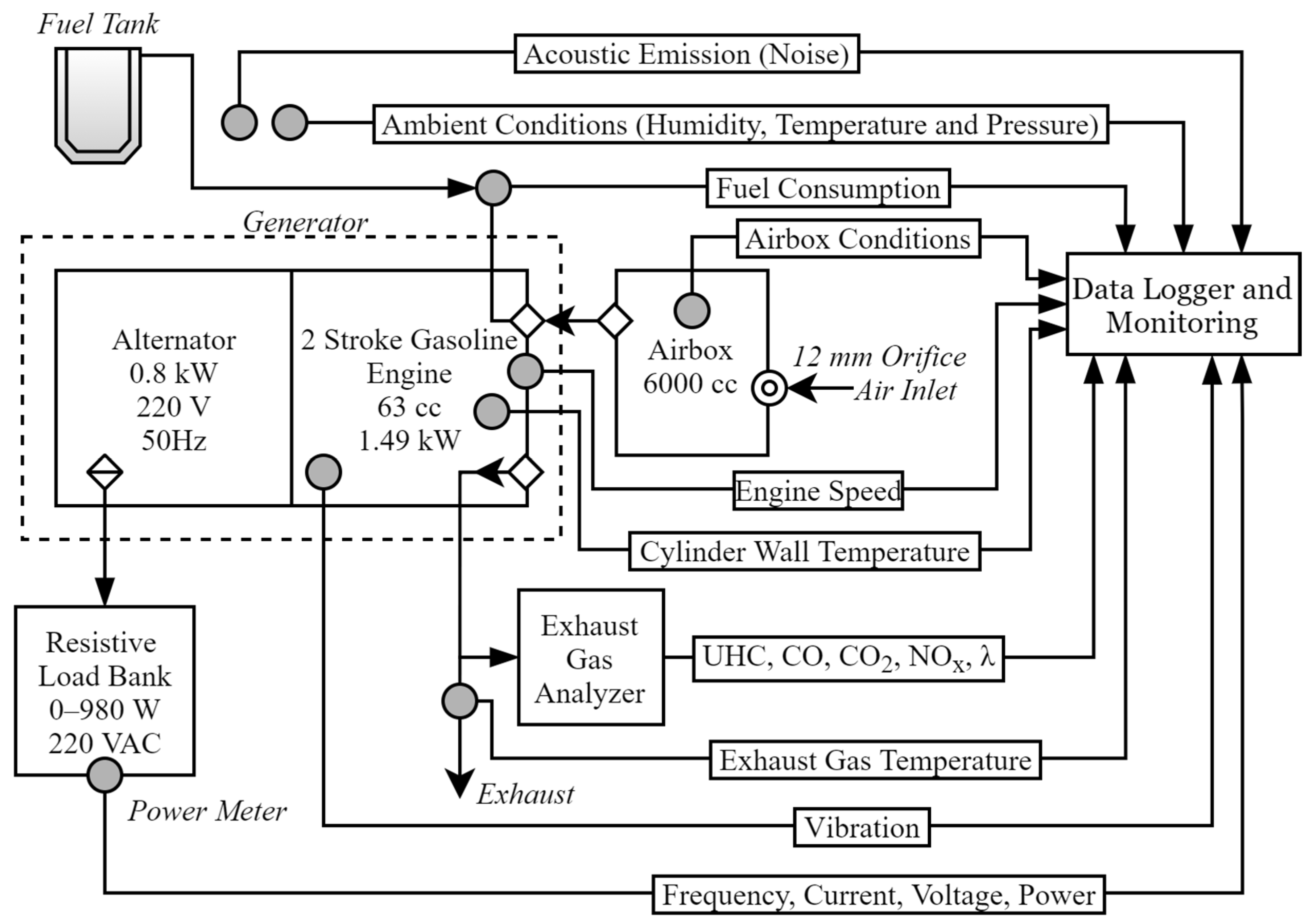
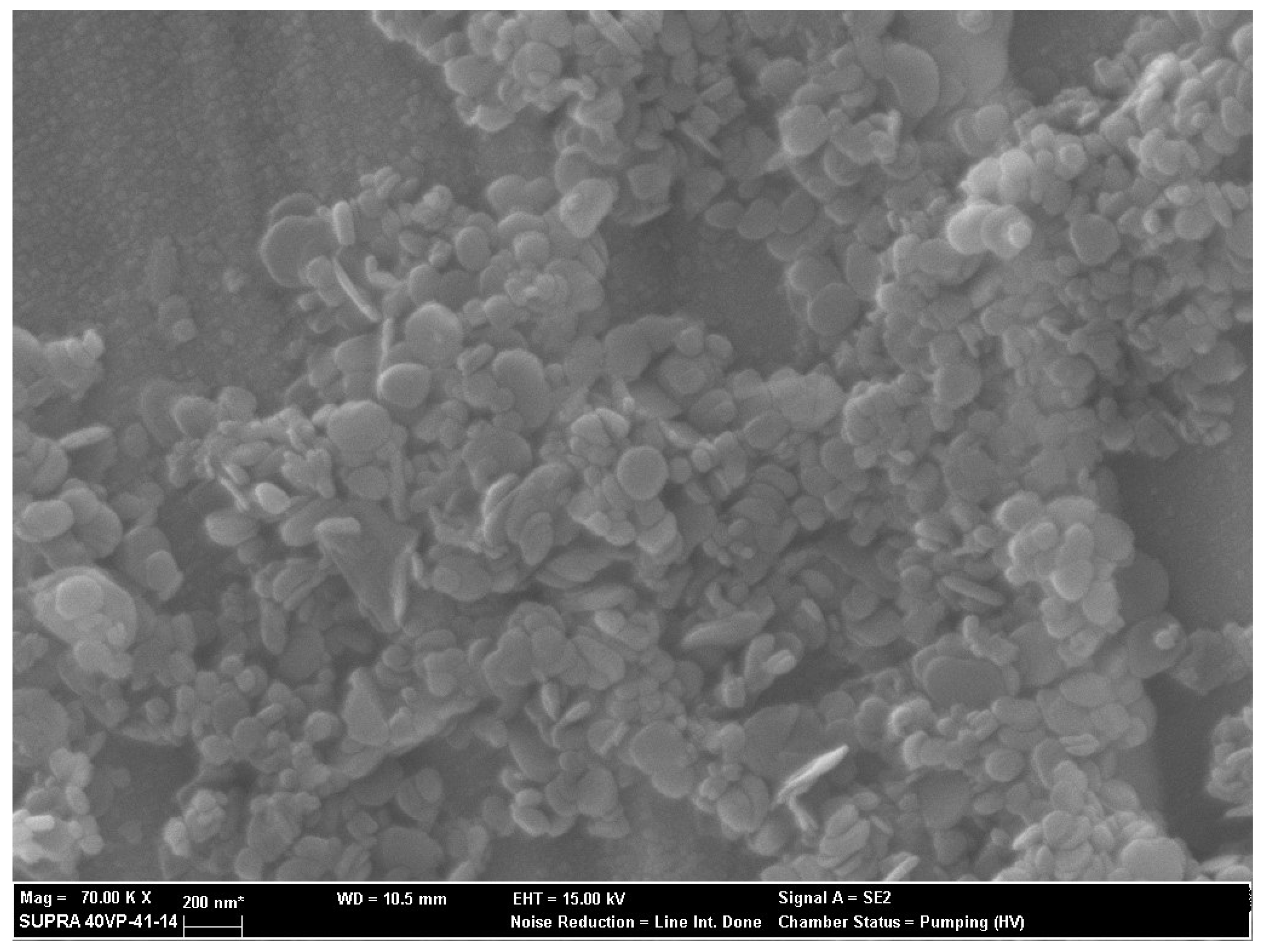



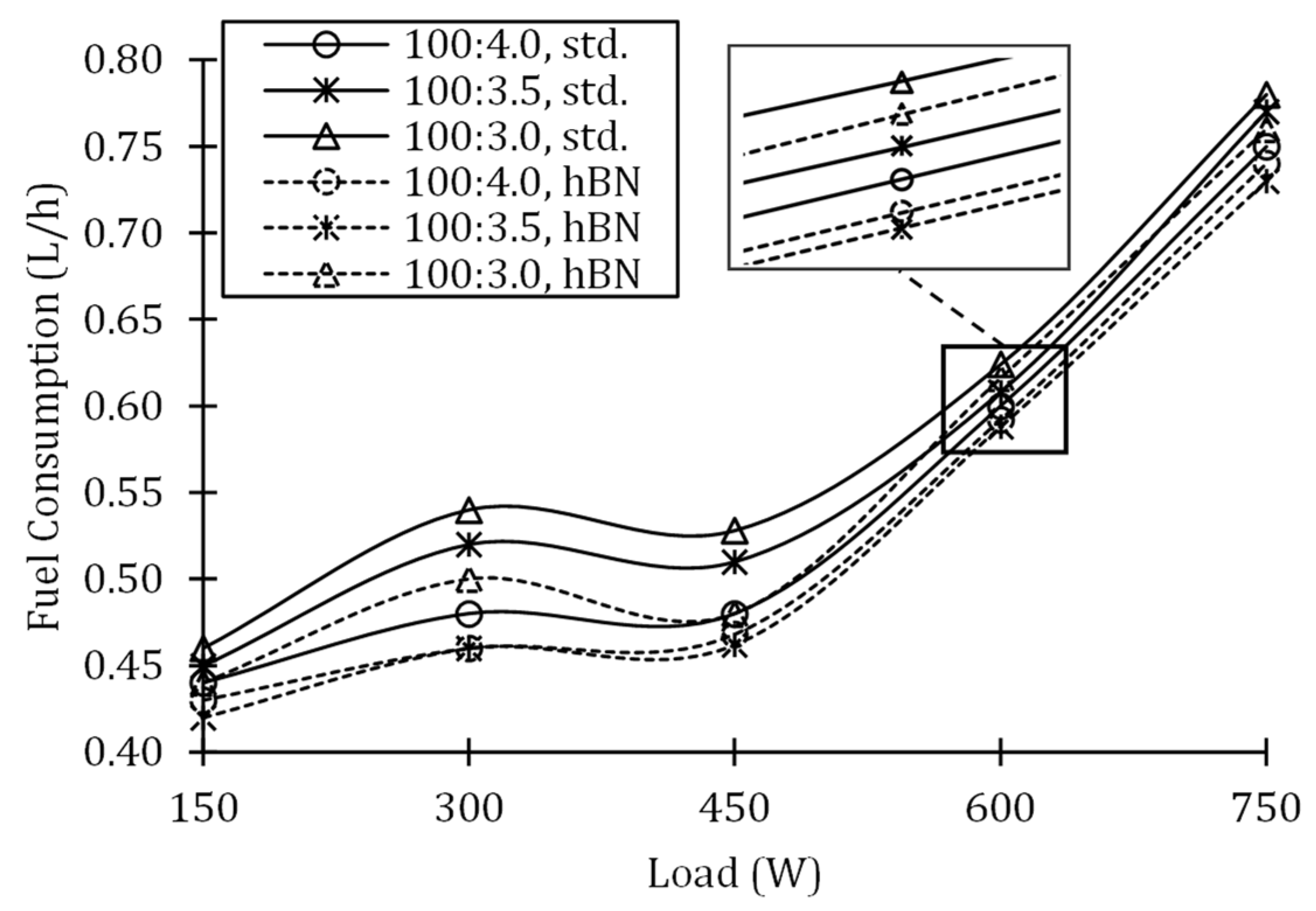

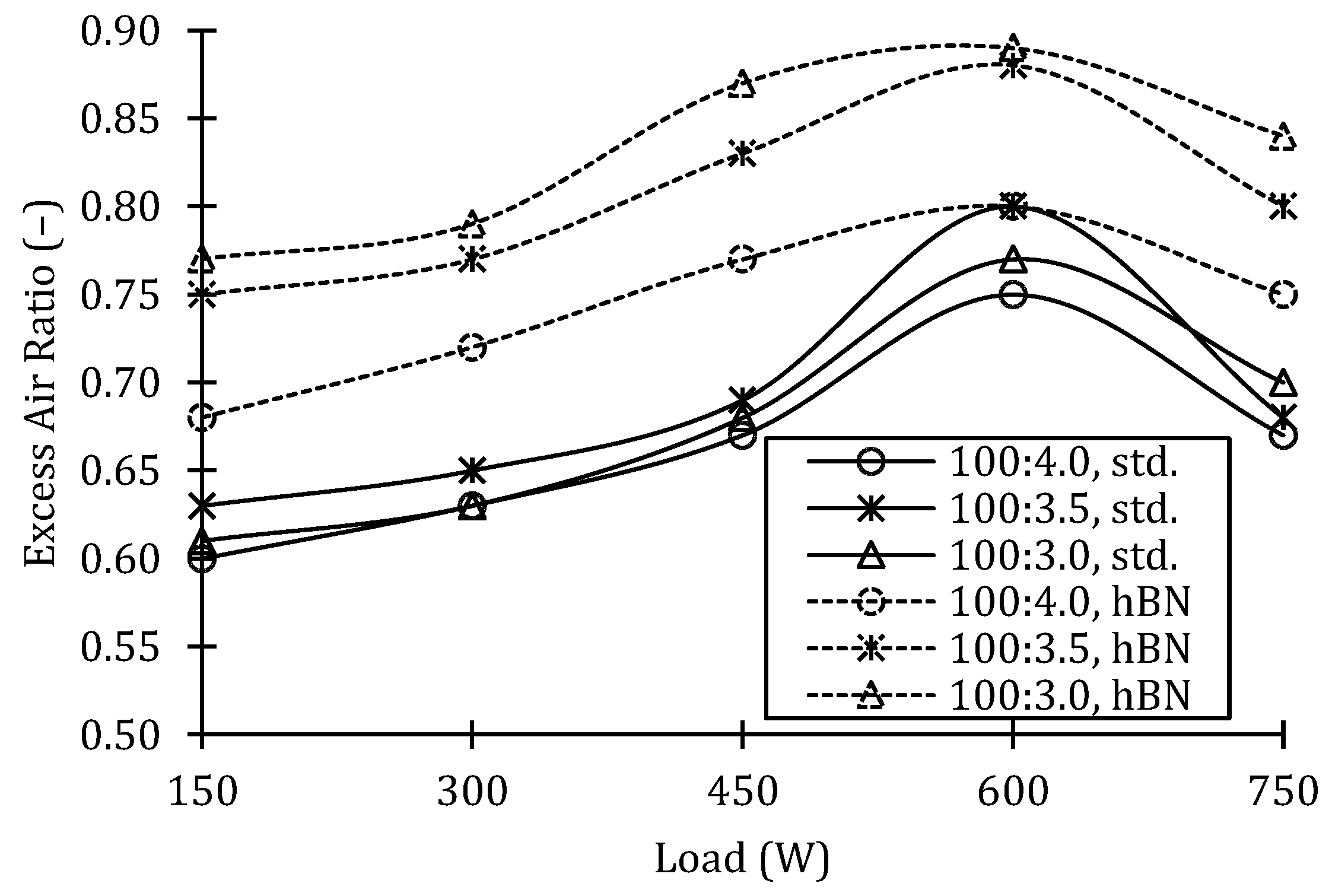
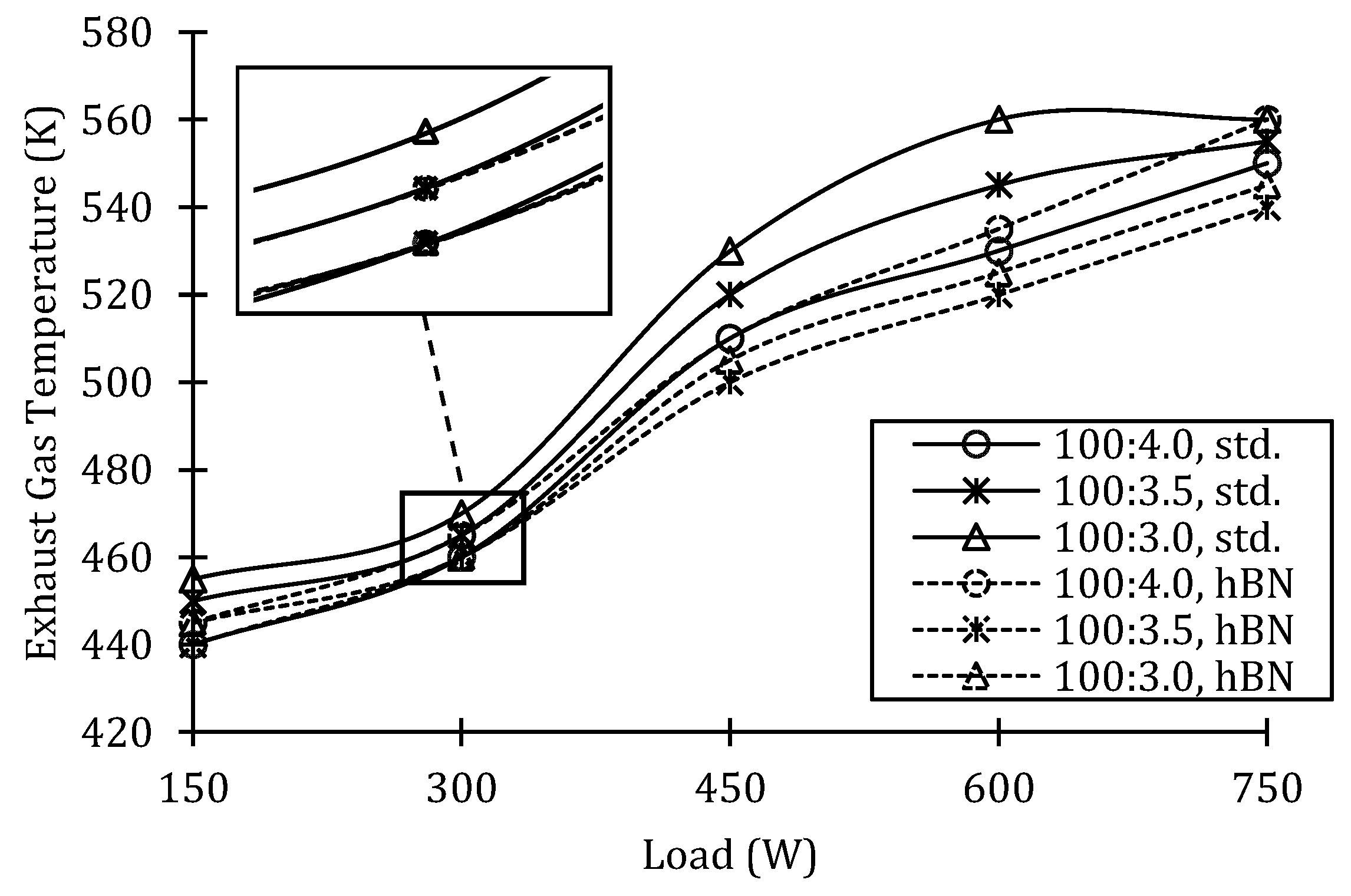
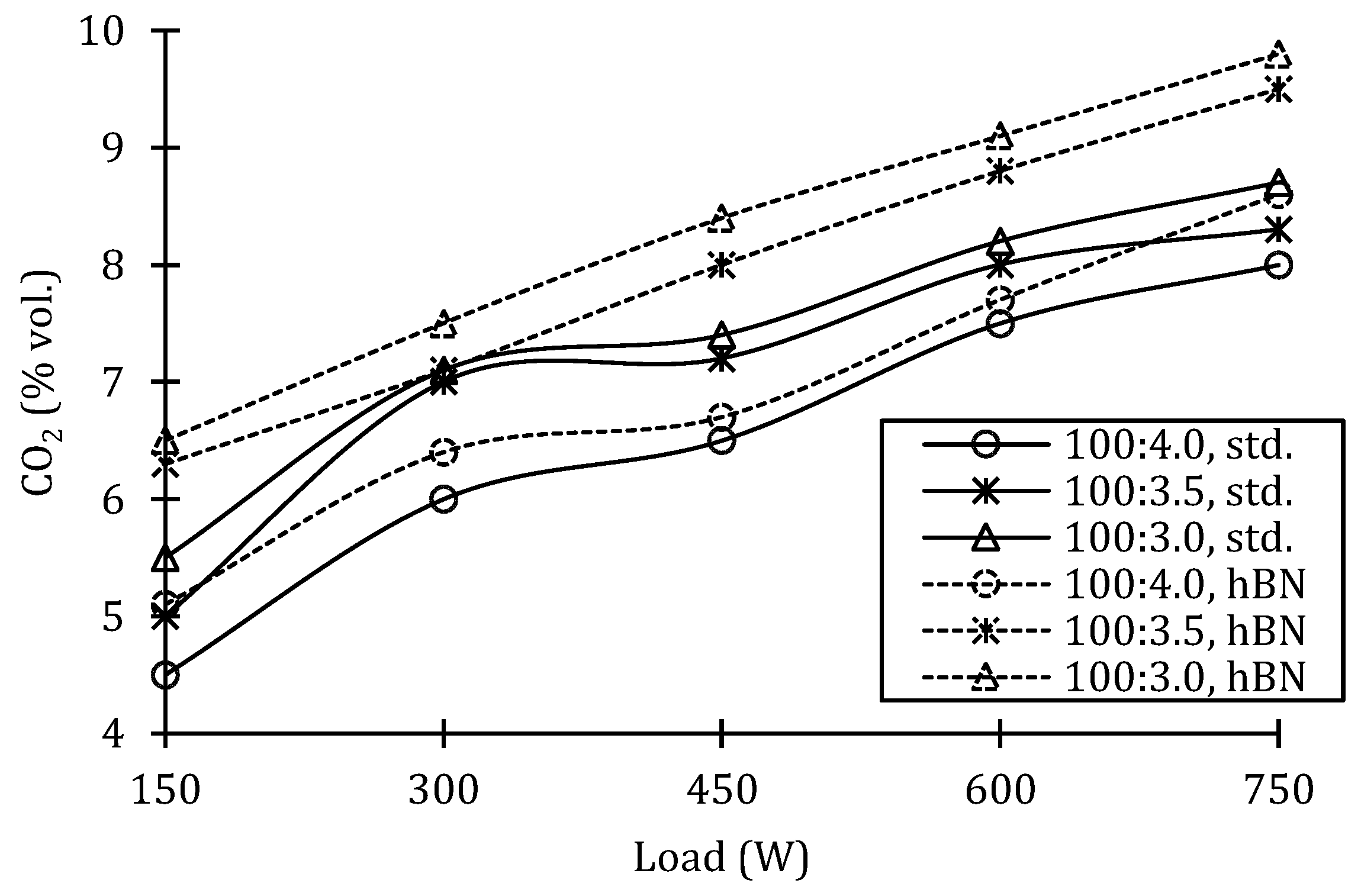
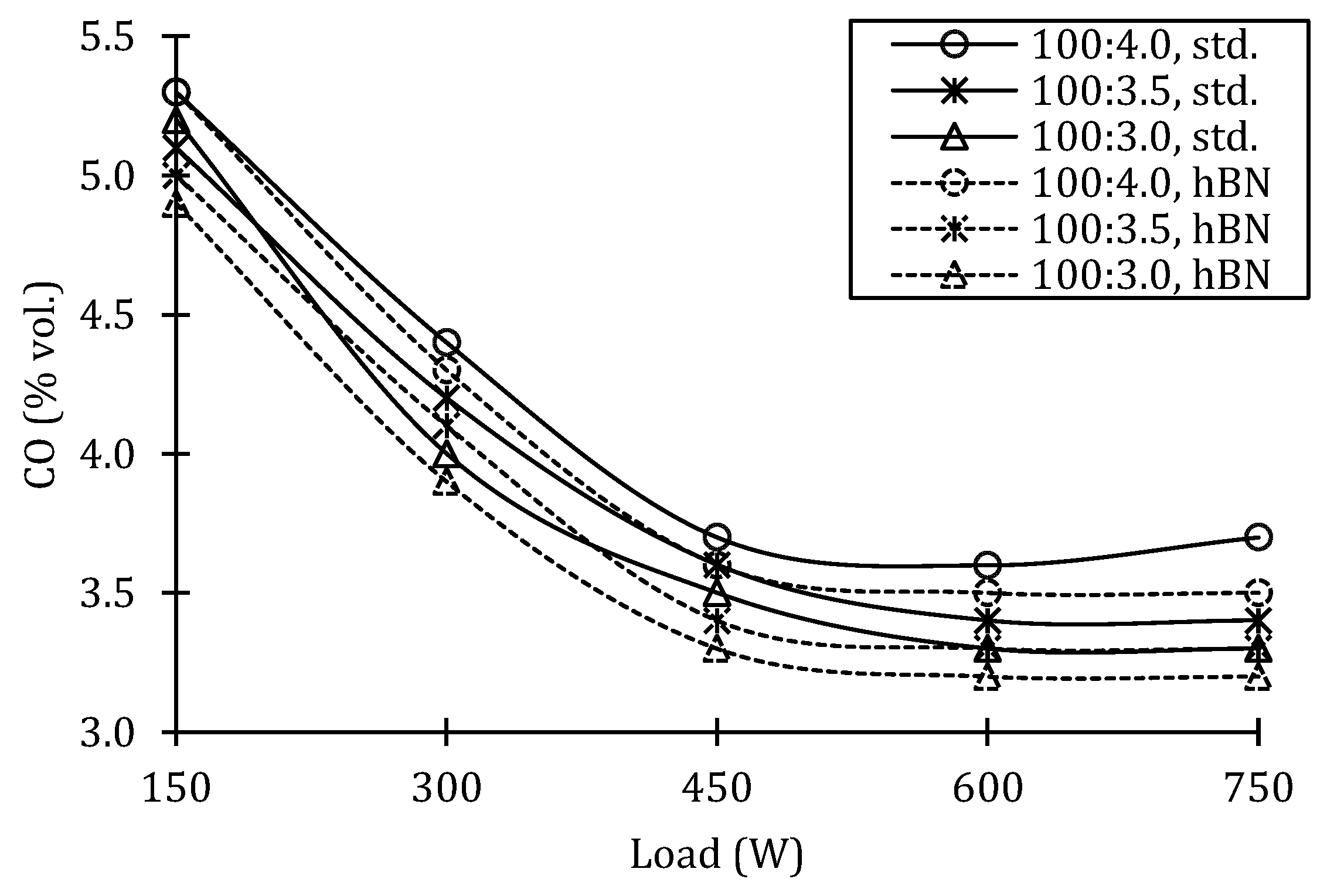
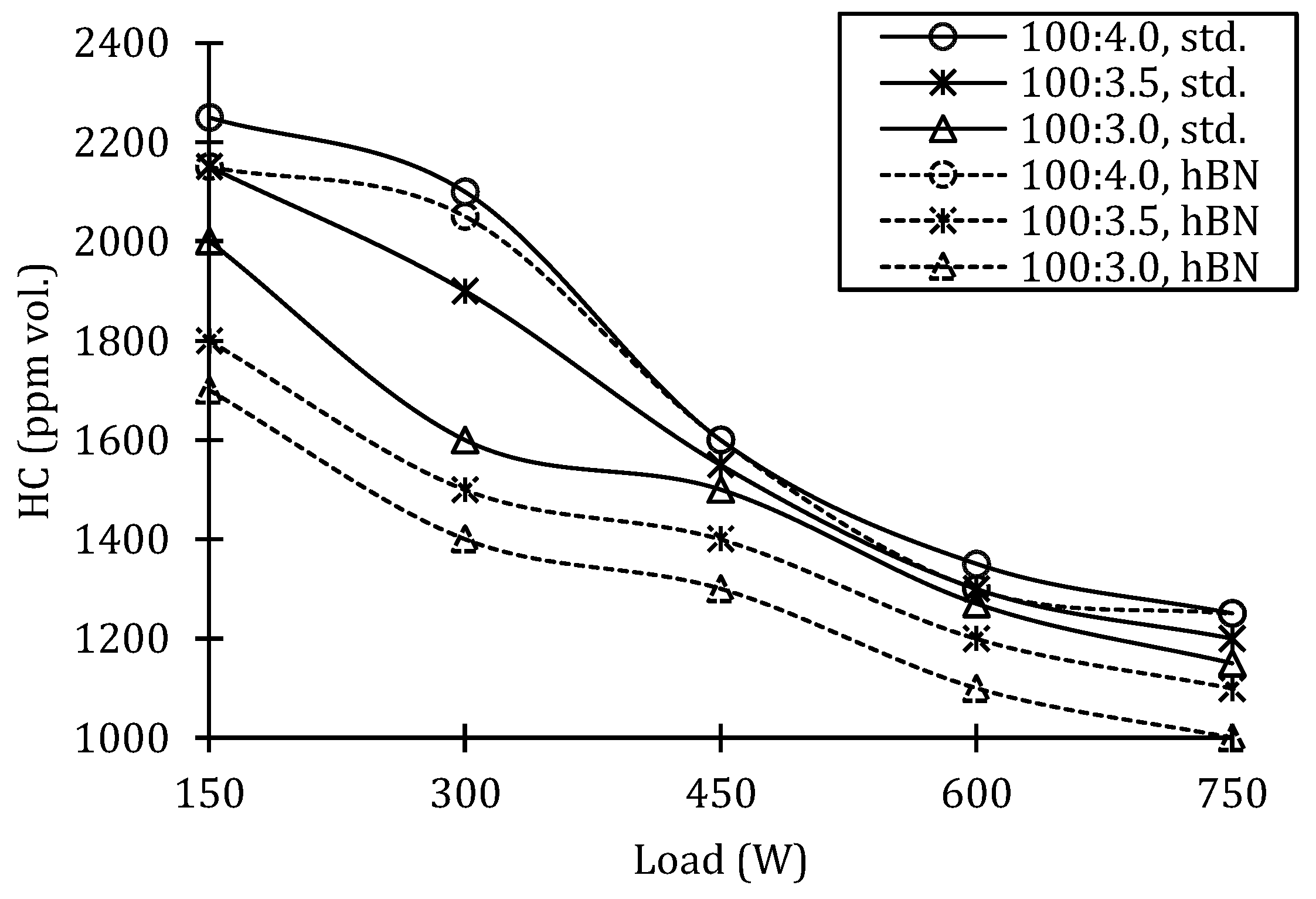
| Generator Output | 220 VAC, 50 Hz, Single Phase 750 W (0.8 kVA) Rated 800 W (1.0 kVA) Maximum |
| Power Factor (Cos ɸ) | 1.00 |
| Engine Displacement | 63 cc |
| Engine Output Power | 1490 W maximum |
| Engine Rotation | Counterclockwise |
| Engine Type | Horizontal, single cylinder, 2-stroke, naturally aspirated |
| Engine Cooling System | Forced air |
| Engine Fuel | 87+ octane mixed with lubricant oil |
| Lubricant Type | Designed specifically for mixing with gasoline |
| Lubricant Oil | Gasoline-to-oil ratio 100:2 vol. for full synthetic oil 100:4 vol. for mineral oil |
| Sound Level | 56 dB at 7 m |
| Measurement | Operating Range | Resolution | Accuracy |
|---|---|---|---|
| Lambda | 0–4 | 0.001% | ±0.2% |
| CO (%) | 0–14 | 0.001% | ±0.2% |
| CO2 (%) | 0–18 | 0.01% | ±1% |
| HC (ppm) | 0–9999 | 1 ppm | ±10 ppm |
| O2 (%) | 0–25 | 0.01% | ±0.2% |
| Measurement | Instrument Used | Operating Range (Accuracy) | Accuracy |
|---|---|---|---|
| Exhaust temperature | MAX 6675 with K-Type Thermocouple | 273–1300 K | ±1 K |
| Conditions of the ambient and the airbox | Bosch BME680 | Pressure: 30–110 kPa Humidity: 0–100% Temperature: 233–358 K | ±1 kPa ±3% ±1 K |
| Fuel consumption | Volumetric Measurement with XKC-Y25 | 0–100 s/40 cc | ±0.5 s/40 cc |
| Power meter | Haseman PRM–10 (True RMS) | Power: 0–999.9 W Frequency: 10–99.9 Hz | ±0.1 W ±0.1 Hz |
| Engine speed | Omron E6A2–C | 360 pulse/rotation | - |
| Properties | hBN Powder |
|---|---|
| Average Diameter Particle Size | ∼70 nm |
| Real Density | 2250 kg·m−3 |
| Bulk Density | 375 kg·m−3 |
| Thermal Conductivity | 29 W·m−1·K−1 |
| Molecular Weight | 24.82 g·mol−1 |
| Melting Point | 2973 K |
| Specific Heat | 840 J·kg−1·K−1 |
| Friction Coefficient | 0.17 to 0.70 |
| Properties | Method | Value |
|---|---|---|
| Density at 298 K | ASTM D 4052 | 857 kg·m−3 |
| Kinematic Viscosity at 373 K | ASTM D 445 | 9.00 cSt |
| Kinematic Viscosity at 313 K | ASTM D 445 | 62 cSt |
| Viscosity Index | ASTM D 2270 | 117 |
| Flash Point | ASTM D 93 | 384 K |
| Pour point | ASTM D 97 | 301 K |
| Properties | Oleic Acid |
|---|---|
| Chemical Formula | C18H34O2 |
| Molecular Weight | 282.46 g·mol−1 |
| Density | 899 kg·m−3 |
| Melting Point | 287 K |
| Boiling Point | 633 K |
| Purity | ≥99% |
Disclaimer/Publisher’s Note: The statements, opinions and data contained in all publications are solely those of the individual author(s) and contributor(s) and not of MDPI and/or the editor(s). MDPI and/or the editor(s) disclaim responsibility for any injury to people or property resulting from any ideas, methods, instructions or products referred to in the content. |
© 2023 by the author. Licensee MDPI, Basel, Switzerland. This article is an open access article distributed under the terms and conditions of the Creative Commons Attribution (CC BY) license (https://creativecommons.org/licenses/by/4.0/).
Share and Cite
Orman, R.Ç. Effect of Adding Hexagonal Boron Nitride (hBN) Nano-Powder to Lubricant on Performance and Emissions in a Two-Stroke Gasoline Engine. Sustainability 2023, 15, 14605. https://doi.org/10.3390/su151914605
Orman RÇ. Effect of Adding Hexagonal Boron Nitride (hBN) Nano-Powder to Lubricant on Performance and Emissions in a Two-Stroke Gasoline Engine. Sustainability. 2023; 15(19):14605. https://doi.org/10.3390/su151914605
Chicago/Turabian StyleOrman, Recep Çağrı. 2023. "Effect of Adding Hexagonal Boron Nitride (hBN) Nano-Powder to Lubricant on Performance and Emissions in a Two-Stroke Gasoline Engine" Sustainability 15, no. 19: 14605. https://doi.org/10.3390/su151914605
APA StyleOrman, R. Ç. (2023). Effect of Adding Hexagonal Boron Nitride (hBN) Nano-Powder to Lubricant on Performance and Emissions in a Two-Stroke Gasoline Engine. Sustainability, 15(19), 14605. https://doi.org/10.3390/su151914605






